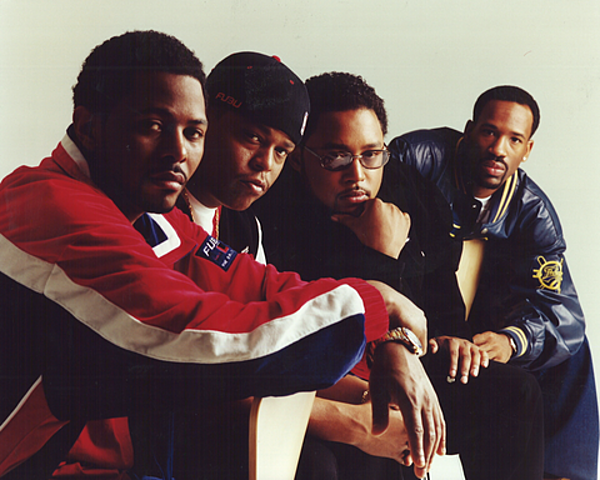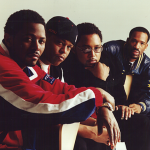From Handsewn Hats to Millions: The Rise and Fall of FUBU

Before popular hip-hop influenced clothing brands like Rocawear, Enyce, P.Miller, and Sean John, there was FUBU. The company burst onto the hip-hop scene in 1992, and paved the way for the urban clothing lines that would come after.
On March 24, 1989, Daymond John, who had just turned 20, hit the streets of Queens, New York and began selling his hand-sewn wool beanies with a string knotted on top. According to The Washington Post, John made $800 within the first hour and a half of selling his homemade hats outside to pedestrians on the sidewalk.
This wasn’t the first time John tried his hand at selling clothing—he’d started out selling t-shirts.
“I went and printed up some shirts when the Rodney King riots were happening in Los Angeles, with lines like “What happened to poor Rodney King?” Then Mike Tyson got incarcerated, and we did the whole “Free Mike Tyson” shirts,” he told The Washington Post.
After creating and selling the shirts, a light bulb went off. John believed people purchased the shirts quickly because of the emotional slogan attached. After he noticed this trend with his customers, he knew he wanted to create a brand that made people feel something.
John connected with his three friends, J. Alexander Martin, Keith Perrin and Carlton Brown, and the clothing company “For Us, By Us,” or FUBU for short, was created.
The clothing line was not an instant success, however. In an interview with Hot97 in 2017, John explained that for three years— from 1989-1992— FUBU didn’t make any money.
In fact, the company was closed down three times before it began to generate income. John took a job working at Red Lobster to make ends meet and didn’t attend college because he couldn’t afford it.
After an appearance at a trade show in Las Vegas, John and his partners managed to sell $400,000 worth of clothing that didn’t exist yet. After being turned down by 26 banks for a loan, his mother took out a second mortgage on their own home for $100,000.
John turned his home into a working factory, purchasing six sewing machines and all the materials needed to create the FUBU clothing line–incluing hiring seamstresses. John rented out the rooms in his home for money and kept the clothing line going. He eventually quit his job at Red Lobster to focus on the business. During his down time, he would visit hip-hop music video sets and try to coax rappers into wearing FUBU clothing.
In this interview co-founder Keith Perrin gives a candid glimpse into what life was like once FUBU took off.
“First it started with Brand Nubian in one of their videos. Then Ol’ Dirty Bastard wore it in a Mariah Carey video, then Busta Rhymes wore it on one of his videos, and LL Cool J decided to wear FUBU on the ‘Hey Lover’ video with Boyz II Men,” John told Tim Ferris in a 2011 interview. “Our product was front and center on the biggest and most influential personalities for our core consumers.”
In 1996, after going through the $100,000 in loan money, FUBU was in trouble. John took an ad out in The New York Times and got the attention of Samsung. It read, “A million dollars in orders, need financing.” The ad worked, and FUBU got backing from Samsung, which propelled the company to global distribution.
By 1998, FUBU had peaked, with sales over $350 million USD. The success of the clothing line during this time can largely be attributed to rappers and R&B singers who wore the clothing in their music videos.
In 1999, LL Cool J was featured in a GAP commercial, LL, wore a FUBU hat, and without GAP knowing, added FUBU’s entire name in the commercial giving the clothing line free marketing.
Once GAP realized this they pulled the commercial, but the free mass marketing had already been done. Not only did FUBU partner with hip-hop, pop, and R&B artists, in 2001, FUBU released a compilation album titled The Good Life, featuring artists like Nate Dogg, LL Cool J, and Keither Murray. Although the album sold half a million units, it cost them $5 million to make.
“We didn’t know our numbers, we didn’t look at our numbers, we were spending money like drunken sailors, we were getting caught up,” John said in an interview with Fast Company in 2013.
“Fatty Girl” was the lead single from FUBU’s The Good Life album.
By 2003, FUBU left the U.S. market, keeping only their footwear division, instead building their business in Asia and Europe. In the book, The Brand Within, John explained that FUBU had too much product and that’s why it began to decline.
“Once you hit mark-down bins, it’s tough to climb out, because you’ve lost the sense that your clothes are fresh and vibrant.”
They did acquire other clothing brands like Coogi, Drunkn Munky, Heatherette, Kappa USA, and Crown Holder. In 2009, their worldwide revenues reached $200 million. While the company didn’t collapse, there wasn’t much talk about bringing the clothing line back to the U.S.
It wasn’t until 2009 that John announced the brand would make a comeback. FUBU is currently back in the U.S. and they have teamed up with PUMA for a collaboration. The FUBU.com has all new gear that gives off a 90s hip-hop vibe.
FUBU has stood the test of time and still remains a brand that’s made for us, by us.
50 Greatest Female R&B Artists of the 90s
Go to Source
Author: Sharee Hereford
Powered by WPeMatico



